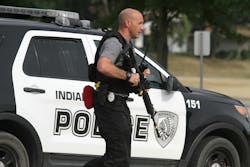Averting Tragedy: EBM Intelligence Active Shooter Prevention Report
Active Shooter events in our nation are, unfortunately, seeming to increase in pace and occurrence. It’s an ugly truth, but they are nothing new. Based on historical data we can document the first attack on an elementary school using a firearm back to 1891 in New York state. Active shooter events occurred rarely from then until 1999 when the Columbine School attack was broadcast live via satellite on major television networks. It was then that America saw a school attack “firsthand,” and the words “active shooter” became a household term. Since 1999, the incidents of active shooter attacks have evolved and accelerated now having taken place in every venue from schools to colleges to business buildings to shopping malls.
When the attack at Covenant Presbyterian school happened on Monday, March 27th, 2023, it was as shocking as every other attack; horrific, heinous and tragic. For Endeavor Business Media what made the attack different is that it was almost across the street from our corporate headquarters. Our CEO can literally look out his office window and see the Covenant Presbyterian Church steeple across the parking lot. When an active shooter attack occurs that close to home it changes your perspective. The events are no longer something that happened somewhere else, although that makes them no less tragic. Suddenly it’s right there, in your face and slamming into your conscience like a sledgehammer.
Unlike many media outlets, Endeavor Business Media (EBM) doesn’t have a political agenda. Corporately we feel a duty to report impartially on the variety of items that impact the industries we serve; and that number is vast. What our corporate leadership realized is that one of those industries is law enforcement, and what better group of people to ask about preventing attacks than those who respond to them? With that thought, and high motivation to identify a solution to the reduction or elimination of active shooter events, EBM polled our law enforcement readership.
The survey was distributed to all law enforcement readership. That differs from other organizations who only poll Chiefs, Sheriffs or other agency executives. This survey sought to get the informed opinion of officers at every rank from agencies of every size and in every region of our nation. What follows is a look at the respondents and their recommendations or thoughts on how best to prevent active shooter attacks.
The survey was released on April 13, 2023, about two weeks after the Covenant Presbyterian attack. It stayed available for completion through April 24th and received 559 completions. Our market research division reports a potential margin of error of +/- 4.1%.
65% of the respondents were full time law enforcement officers, 27% retired law enforcement officers with another 9% either serving part time or in a volunteer capacity. There’s little doubt that some of the retired officers now serve part time or as volunteers. The drive to serve doesn’t just go away when an officer retires. Recognizing that there is a plethora of types of agency, we identified 46% of the respondents as police officers, 16% as Sheriff’s agency members, 7% federal officers, 5% state officers with the remainder a mix of campus, private, Department of Corrections and other types of agencies.
41% of the respondents reported working in a suburban area, with 37% in an urban area and 22% in a rural area. That makes a total of 63% not working within a city or urban area. Experienced officers will tell you that the operational protocols, population density and number of on duty officers in a given area is vastly different between an urban area and a rural area. That also means that response times can be vastly different and the number of officers available to respond is different.
The largest number of respondents live and work in the Mid-Atlantic and Southern Atlantic states, those including New York, New Jersey, Pennsylvania and farther south. 47% of the respondents were from those areas. The smallest number of recipients were from East South Central states to include Alabama, Kentucky, Mississippi and Tennessee.
As far as time on the job is concerned, 29% of the respondents reported being in law enforcement over 30 years. Of all of the respondents, the average mean time “on the job” was 22.5 years. If you look back from the spring of 2023, subtracting 22.5 years, you end up in the fall of the year 2000 – less than 1.5 years after Columbine and near the beginning of the Active Shooter Response protocol advent. That means that for the average respondent to our survey, Active Shooter Response has been a reality throughout their career behind a badge.
The largest rank group represented as respondents to our survey was that of patrol officers to include any officer, deputy, trooper, etc. carrying the rank of Corporal or below. That group accounted for 35% of our respondents. If you add in the Sergeants (18%) and Lieutenants (10%) you see that 63% or roughly 2/3 of the respondents are at a rank to be answering calls on the street. That’s an important qualifier for the respondents as you weigh their thoughts and opinions on solutions; they are the most likely to have to respond to the events, running toward the threat. They have the most to lose and can have the greatest potential impact on minimizing casualties once an attack has occurred.
It's easy to understand that the response capabilities, just in pure manpower, is different between large agencies (i.e. NYPD with it’s 34K+ officers) and small agencies, some numbering less than five full time officers. We identified agency size in the survey and found that 65% of the respondents work for agencies with 100 sworn officers or less. That is an important agency characteristic to identify as it falls in line with the national representation of agency sizes. The majority of agencies in our nation have fewer than 100 officers and are often overlooked when it comes to grant funding, training opportunities, etc. as the focus remains on larger, more reported on, agencies.
Having identified all of those officer and agency characteristics, our first priority concerning Active Shooter Response was to identify how common, and how up to date, response training is. When asked how recent such training was delivered at their agency, 66% of the respondents said they’d received such within the past year. 16% reported having received the training over a year ago with 13% not able to remember when they’d had such training. Sadly, 4% reported never having attended Active Shooter Response training.
When questioned about department policy for response protocol, 56% reported single-officer, first on scene or all available policies. 9% reported a four-officer diamond response still being used and, amazingly, 7% reported only a SWAT response. When an active shooter attack occurs, time equals casualties. The fastest and best way to limit loss of life is to limit the time the shooter has. Waiting for four officers to get on scene, or waiting for SWAT to arrive, gives the attacker(s) more time to injure or kill more victims. This is precisely why the response protocols evolved to single-officer or first-on-scene as the preferred method.
After identifying all that information, EBM’s survey got into the true meat of what we wanted to know: Based on the respondent’s experience in law enforcement, what was the best way to prevent active shooter events? 44% of the respondents felt that Armed guards/officers/staff was the solution. A further 27% believed that training and education about Active Shooter events was a solution. 20% believed that protocols and equipment within the schools themselves were the answer. This would include access control, weapons detection, reaction protocols, etc. 6% of the respondents felt that gun control was the solution while 2% felt that doing away with gun free zones was the solution.
When asked what proposed ideas they supported or believed would be most effective in preventing active shooter events, the three most supported all revolved around training and education for law enforcement, fire fighters, EMS (97%), schoolteachers (97%) and even the public (94%). Preventing felons from purchasing or possessing a firearm (86%), requiring background checks for all firearm purchases (83%) and prohibiting those with mental health issues from purchasing or possessing a firearm (68%) were all on the list in declining order.
There was support shown for prohibiting those convicted of domestic violence from purchasing or possessing a firearm (64%). Red flag laws that allow weapons to be confiscated from at risk individuals (53%) and requiring those purchasing a firearm to waive their privacy rights pertaining to their mental health records as part of the background investigation (48%) show an almost even division of outlook among the respondents. Allowing teachers to carry firearms while at school (53%) and arming teachers with firearms while at school (45%) was also listed. (Author’s Note: The 8% difference is likely about ownership of the weapon: personal ownership vs. the school providing the firearm.)
Banning the sale of semi-automatic weapons to civilians (non-law enforcement personnel) was opposed or strongly opposed by 83% of the respondents. Banning the possession of the same type weapon was opposed or strongly opposed by 81% of the respondents.
That’s a lot of data to sort but it provides valuable insight regarding what our experienced and trained law enforcement officers today feel are the best ways to limit active shooter attacks and, where they occur, the best ways to limit loss of life. Training, for all potentially involved parties, is a priority for reaction training. If the event occurs, the fastest response by armed and trained personnel is the best response. Historically speaking, very few active shooters surrender. The large majority either commit suicide when faced with an armed response or they are neutralized by an armed “good guy.”
Where gun control is concerned, despite some recent high profile legislative attempts to limit access to particular weapons, the data shows greater support from law enforcement toward limiting access for convicted felons, those who have demonstrated violent tendencies and those with mental health challenges.
As Active Shooter Response protocols continue to evolve, we expect to see more attention given to the immediate responder as opposed to the first responders. The immediate responder is the person closest in proximity to the bad actor when the attack starts. If the immediate responder is armed, and/or sufficiently trained and motivated, the number of casualties will be limited as compared to the count if such an immediate responder wasn’t there.
Finally, we at EBM would encourage all employers, corporations, business locations, schools, etc. to develop or contract active shooter response training and to make sure it’s delivered on a regular schedule. How to avoid being a victim and how to prevent access to a ready pool of targets can go a long way to limiting casualties should an active shooter attack occur at your location. Act responsibly; recognize the potential threat; do what you can to prevent it or lessen its impact. The difference can literally be counted in the number of lives lost… or saved.
About the Author
Lt. Frank Borelli (ret), Editorial Director
Editorial Director
Lt. Frank Borelli is the Editorial Director for the Officer Media Group. Frank brings 20+ years of writing and editing experience in addition to 40 years of law enforcement operations, administration and training experience to the team.
Frank has had numerous books published which are available on Amazon.com, BarnesAndNoble.com, and other major retail outlets.
If you have any comments or questions, you can contact him via email at [email protected].

